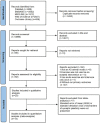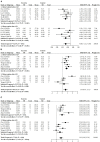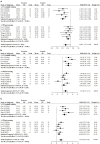Effect of exercise on cognitive function and synaptic plasticity in Alzheimer's disease models: A systematic review and meta-analysis
- PMID: 36704501
- PMCID: PMC9872519
- DOI: 10.3389/fnagi.2022.1077732
Effect of exercise on cognitive function and synaptic plasticity in Alzheimer's disease models: A systematic review and meta-analysis
Abstract
Introduction: Cognitive decline is a central manifestation of Alzheimer's disease (AD), and its process is inseparable from changes in synaptic plasticity. The aim of this review was to summarize and evaluate the effectiveness of exercise on cognitive function and synaptic plasticity in AD animal models.
Materials and methods: Eligible studies were searched from PubMed, MEDLINE, EMBASE, Web of Science, and Cochrane Library from April to May 2022. The risk of bias was evaluated by Systematic Review Centre for Laboratory Animal Experimentation (SYRCLE). The Morris water maze (MWM) test and synaptic plasticity were considered outcome measures. Data were analyzed using random-effects meta-analyses using the software Stata. Heterogeneity was examined by using I2 test. Sensitivity analysis and publication bias were also assessed.
Results: A total of 20 randomized controlled studies were eligible for study inclusion. Compared with controls, exercise decreased escape latency (SMD = -0.86, 95% CI: -1.21 to -0.50, P < 0.001), increased platform crossover numbers (SMD = 1.34, 95% CI: 0.57-2.11, P = 0.001) and time in the target quadrant (SMD = 1.65, 95% CI: 0.95-2.36, P < 0.001) and the expression of PSD95 (SMD = 0.73, 95% CI: 0.25-1.21, P = 0.003) in AD animals. The results of the subgroup analysis showed that exercise before AD had a greater effect on escape latency (SMD = -0.88, 95% CI: -1.25 to -0.52, P < 0.001), platform crossover numbers (SMD = 1.71, 95% CI: 1.23-2.18, P < 0.001), time in the target quadrant (SMD = 2.03, 95% CI: 1.19-2.87, P < 0.001) and the expression of PSD95 (SMD = 0.94, 95% CI: 0.19-1.69, P = 0.014) than exercise after AD. The results of the subgroup analysis also showed that treadmill running might be an appropriate exercise type.
Conclusion: Our findings suggested that exercise had a potential effect on improving cognitive function and synaptic plasticity. It can play a better neuroprotective role before AD.
Systematic review registration: PROSPERO, identifier: CRD42022328438.
Keywords: Alzheimer's disease; animal; cognitive function; exercise; synaptic plasticity.
Copyright © 2023 Guo, Yang, Zhang, Xu and Li.
Conflict of interest statement
The authors declare that the research was conducted in the absence of any commercial or financial relationships that could be construed as a potential conflict of interest.
Figures






Similar articles
-
Effect of berberine on cognitive function and β-amyloid precursor protein in Alzheimer's disease models: a systematic review and meta-analysis.Front Pharmacol. 2024 Jan 16;14:1301102. doi: 10.3389/fphar.2023.1301102. eCollection 2023. Front Pharmacol. 2024. PMID: 38293672 Free PMC article.
-
Effect of acupuncture on neuroinflammation in animal models of Alzheimer's disease: A preclinical systematic review and meta-analysis.Front Aging Neurosci. 2023 Mar 1;15:1110087. doi: 10.3389/fnagi.2023.1110087. eCollection 2023. Front Aging Neurosci. 2023. PMID: 36936500 Free PMC article.
-
Regulatory role of the endocannabinoid system on glial cells toward cognitive function in Alzheimer's disease: A systematic review and meta-analysis of animal studies.Front Pharmacol. 2023 Mar 3;14:1053680. doi: 10.3389/fphar.2023.1053680. eCollection 2023. Front Pharmacol. 2023. PMID: 36959856 Free PMC article.
-
Effects of mesenchymal stem cells transplantation on cognitive deficits in animal models of Alzheimer's disease: A systematic review and meta-analysis.Brain Behav. 2018 Jul;8(7):e00982. doi: 10.1002/brb3.982. Epub 2018 Jun 6. Brain Behav. 2018. PMID: 29877067 Free PMC article.
-
Blood levels of circulating methionine components in Alzheimer's disease and mild cognitive impairment: A systematic review and meta-analysis.Front Aging Neurosci. 2022 Jul 22;14:934070. doi: 10.3389/fnagi.2022.934070. eCollection 2022. Front Aging Neurosci. 2022. PMID: 35936764 Free PMC article.
Cited by
-
Association of Oxidative Stress on Cognitive Function: A Bidirectional Mendelian Randomisation Study.Mol Neurobiol. 2024 Dec;61(12):10551-10560. doi: 10.1007/s12035-024-04231-3. Epub 2024 May 16. Mol Neurobiol. 2024. PMID: 38753129
-
Exercise orchestrates systemic metabolic and neuroimmune homeostasis via the brain-muscle-liver axis to slow down aging and neurodegeneration: a narrative review.Eur J Med Res. 2025 Jun 12;30(1):475. doi: 10.1186/s40001-025-02751-9. Eur J Med Res. 2025. PMID: 40506775 Free PMC article. Review.
-
Effectiveness of exercise for improving cognition, memory and executive function: a systematic umbrella review and meta-meta-analysis.Br J Sports Med. 2025 Jun 3;59(12):866-876. doi: 10.1136/bjsports-2024-108589. Br J Sports Med. 2025. PMID: 40049759 Free PMC article.
-
Early Detection of Alzheimer's Disease in Postmenopausal Women Using Thalamic Subnuclear Volumetry.J Clin Med. 2023 Oct 30;12(21):6844. doi: 10.3390/jcm12216844. J Clin Med. 2023. PMID: 37959308 Free PMC article.
-
Treadmill exercise pretreatment ameliorated structural synaptic plasticity impairments of medial prefrontal cortex in vascular dementia rat and improved recognition memory.Sci Rep. 2024 Mar 26;14(1):7116. doi: 10.1038/s41598-024-57080-4. Sci Rep. 2024. PMID: 38531892 Free PMC article.
References
Publication types
LinkOut - more resources
Full Text Sources
Miscellaneous

